The Collision Between Cheongsam and Lolita
The Cheongsam
The Cheongsam, also known as a Qipao or Mandarin gown, is classic attire woven from embroidered silk or even satin brocade. It is accentuated by high collars, hemmed slits on the sides, and a tight-fitting of the waist, which may be an inspiration from western influence. The Chinese influence dominates the choice of embroidery as many brides opt for Phoenix or Dragon designs on their dresses. The mandarin collar is an important part of the Qipao, carrying both aesthetic and historical significance.
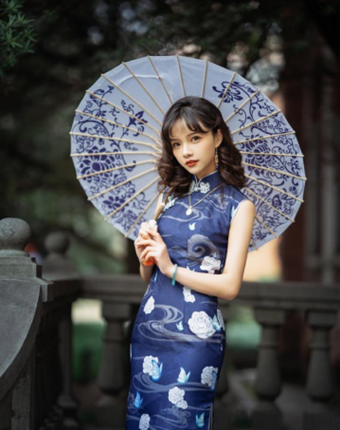
It was introduced when the Manchurian people established their dominance in China with the start of the Qing dynasty. This upright collar which typically stands at around 3-5 cm, is a remnant of ancient Manchurian attire. Additional craftsmanship on the dress exists in the form of knotted buttons that are known as Pankou knots in Chinese. These come in many shapes and designs to select from. The waist fitting further exasperates one’s slim and petite figure that goes well with the dress's long frame.
All of these features are why the Cheongsam is suitable for wear in both formal and casual settings, exemplifying its accessibility in China today, with it being a go-to choice for brides. Here we can observe how the Cheongsam elevates the slim form, further amplified by the floral embroidery, long-reaching skirt, and the dark hues of alluring red.
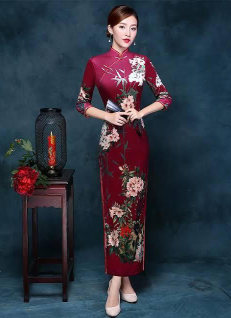
Lolita Fashion
In contrast to the older and cultural mythos of the Cheongsam, Lolita fashion is more recent in its origin. Believed to rise in popularity after the 1970s, this alternate street fashion is associated with Harajuku, a modern region of punk and color in Tokyo. With its fan base rooted in the counterculture, Lolita dress patterns stand in contrasting opposition to mainstream attire while still emanating femininity and cuteness. The biggest way Lolita dresses differ from other Japanese attire is that it draws heavily from classic western lore, fiction, and classical literature, hence allowing inspiration to be taken from a wide set of creative palettes.
You might ask, what even makes a Lolita dress? A core addition to any Lolita dress is a bell-shaped skirt or blouse that’s preferably up to knee level. Kind of how little children wear blouses inspired by fairy-tale princesses. Given its vast fan following, you really don't want to be the person to wear a Lolita dress wrong and get called an Ita. That’s the Japanese word used for a person that dresses in the worst form of Lolita! As for how to dress Lolita, you ought to know your stuff, and it's a good idea to buy from reliable outlets.
An example of a Lolita dress donned by a young woman. Note how the style mimics classical Victorian-era styles commonly seen in children's fairy tales.
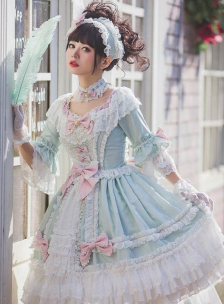
Combining the Cheongsam and Lolita Attire
You might think that these two forms of fashion wouldn’t go well together, given the fact that they represent such different visuals. However, there are custom Lolita dresses that take heavy design inspiration from the Cheongsam. This mix of east meets east will combine the elegance of Cheongsam as it falls into an embrace with the bold, contrasting attention brought out by the Lolita appearance. You essentially end up with a subculture called Qi Lolita or the Han Lolita ( Qi from Qipao/cheongsam ), where the Lolita dress shifts its inspiration borrowing from classical Europe and instead redirects it to China. The Qi-Lolita takes advantage of the Cheongsam’s high collared neckline and
The Qi-Lolita takes advantage of the Cheongsam’s high collared neckline and merges it with lower portions of a typical Lolita dress. The lower skirt portion of the Lolita bears some modifications as well, with it now bearing slits or even Punkao knots for the more traditional fans of the Cheongsam. Not only that, but the overall outgrowing shape of the skirt changes the otherwise longer frame of the Cheongsam, thereby creating an altogether different silhouette.
The upper part, just like the Cheongsam, can now bear insignias or designs from Chinese mythos, like dragons that, when embroidered masterfully, can add a staunch contrast of cultural mythology with the cute meekness of a typical Lolita. This fusion also comes with an added air of freedom regarding what legwear to opt for. You can go with cute knee socks and classic Lolita shoes, or you may make it more Asian by wearing Chinese shoes that sport floral designs and color codes with the overall dress or even the classic cheongsam heels.
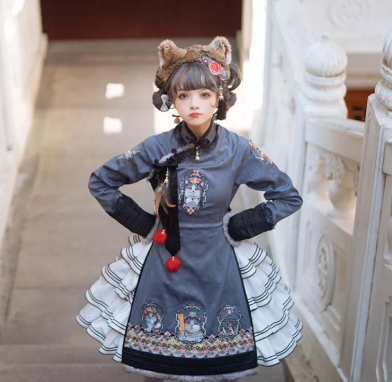
As with any set of worn attire, the Qi Lolita comes with the heritage and themes of both its parent clothes. Both the Lolita and Cheongsam are clothes that are associated with revolution and freedom. Teenage girls mostly adopt lolita fashion on the path to self-discovery as they forge their own sense of style and identity, not being bound by the confounds of strict tradition while still retaining subtle femininity as most Lolita dresses aim to emanate innocence and not sexual allure. Not only that, but the style transcends into other themes that girls might want to identify with, such as Gothic Lolita. It's all about self-expression.
This might seem to be in direct opposition with the older and traditional origins of the Qipao/cheongsam. But let us not forget that just like Lolita fashion, the Cheongsam itself is associated with the desire for freedom and revolution. It reflects the rise of the Chinese woman in the 20th Century. The Cheongsam was made mainstream as women discarded traditional robes, which were collectively named Chungpao. Not only that, but women had finally attained the right to education and, in this new birth of western-inspired democracy, were also free from the shackles of horrific practices such as foot-binding ( the practice of binding a young girl's feet to prevent growth). All these changes share their associations with the Cheongsam as symbols of self-determinacy, self-expression, and freedom.
Given here, we can see a successful fusion of the two styles. Note the Qipao-inspired collar all the way to the blouse in this picture. Below we can see another example.
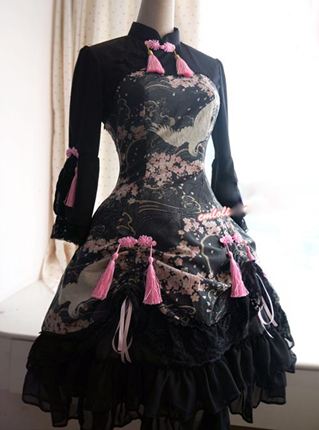
Therefore, it’s very easy to see that both Lolita and Cheongsam are symbols and remnants of countercultures, of struggles to be one’s true self in an environment of strict tradition and to go against the conforms of rigidity. The beautiful dance between these two not only allows for innovation but also maximum style.
